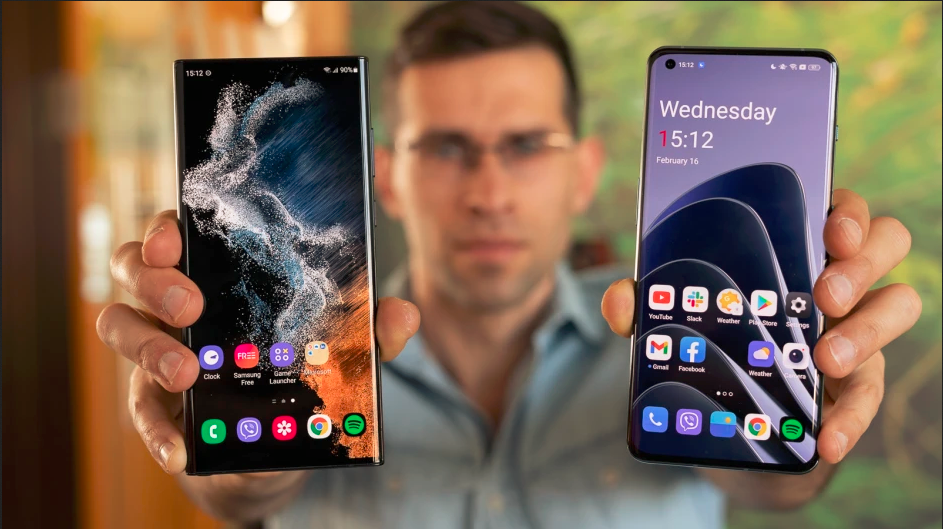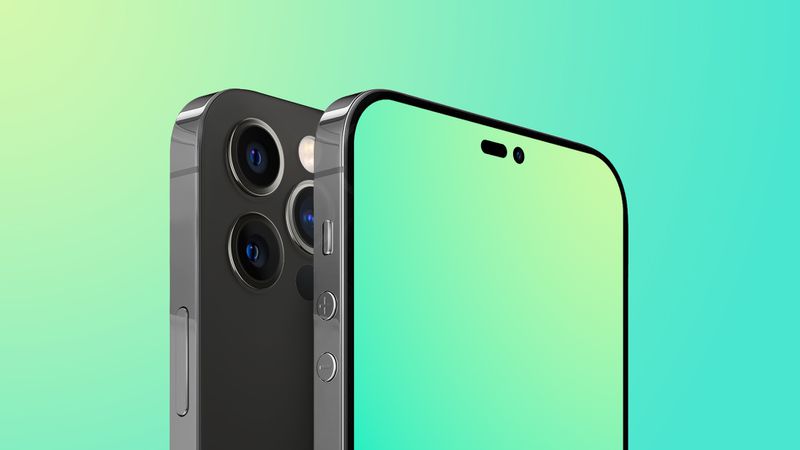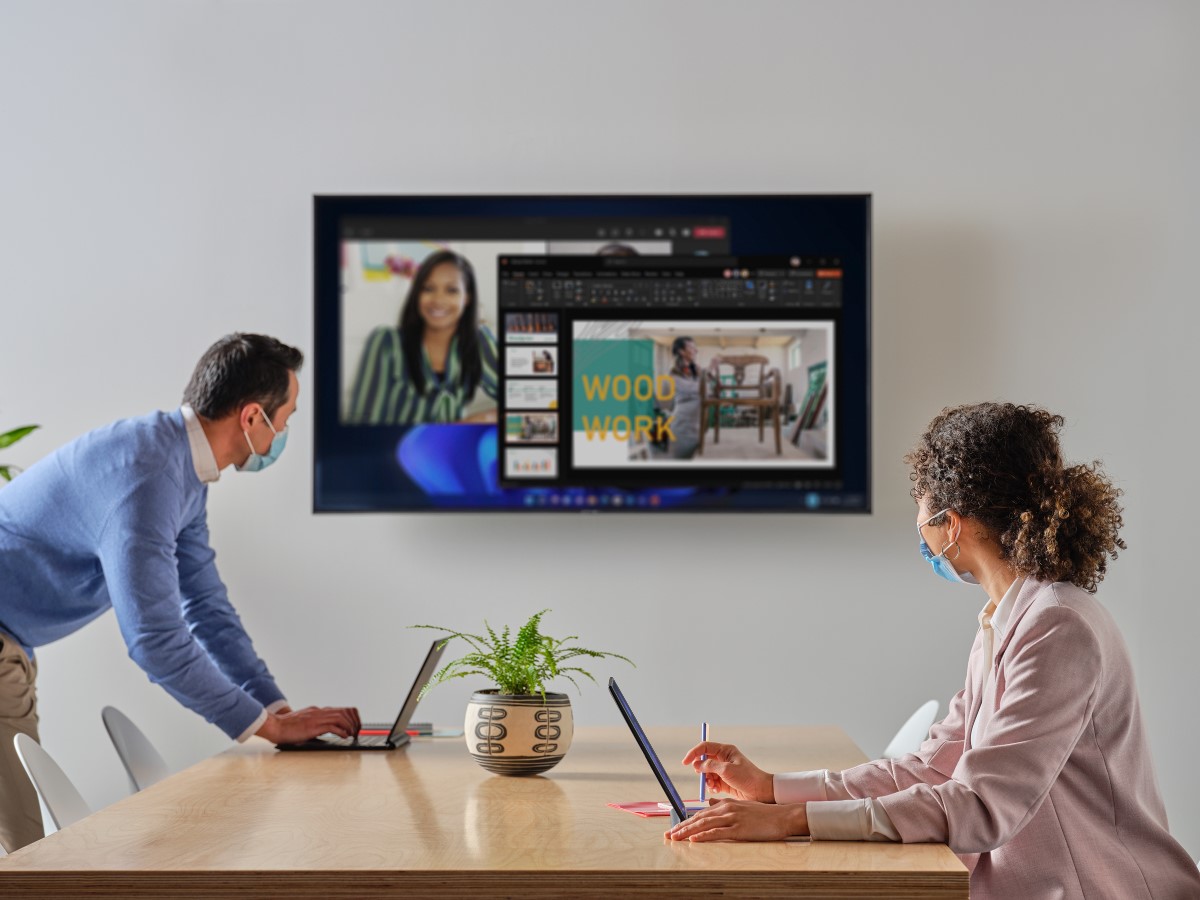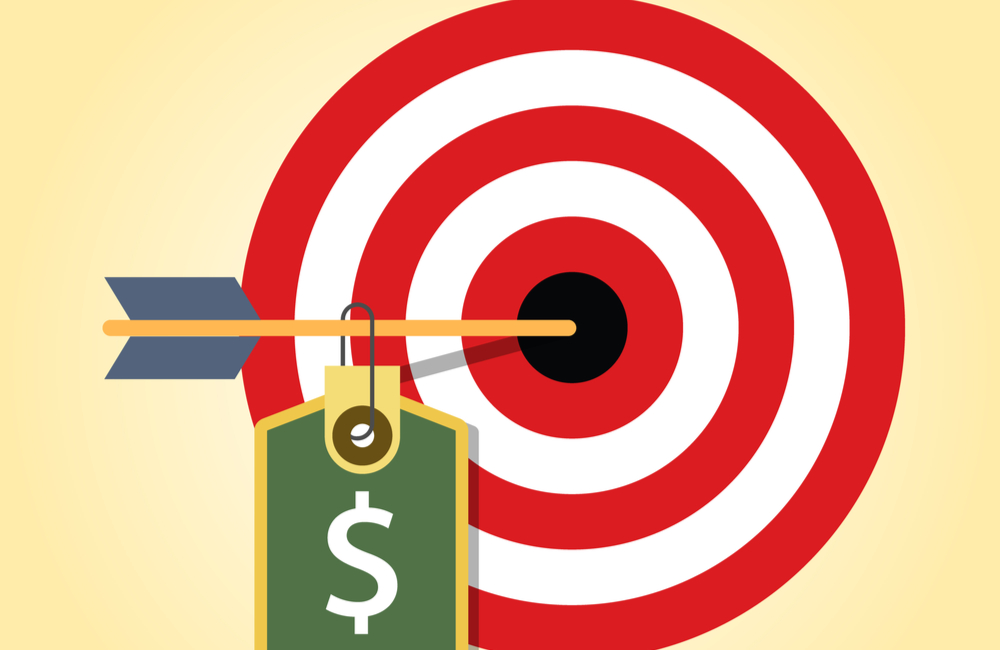WHAT WE HAVE ON THIS PAGE
- Editor’s Choice
- Mobile Data Traffic Growth Over the Years
- Global Mobile Phone Ownership Rates
- Average Daily Mobile Phone Usage Time
- Global Mobile Connectivity Statistics
- Mobile Phone Usage by Age Group
- Mobile Phone Usage by Region
- Generations Most Addicted to Their Phones
- Mobile Internet Usage Trends
- Popular Activities on Mobile Phones
- How North Americans Use Smartphones While Shopping
- Impact of 5G on Mobile Usage Patterns
- Smartphone Penetration and Growth Forecasts
- Gender Breakdown of iPhone vs Android Users Worldwide
- Mobile App Usage Statistics
- Time Spent on Social Media via Mobile Phones
- Americans’ Cell Phone Usage and Habits
- Mobile Device Usage for E-commerce and Payments
- Health and Well-being Effects of Mobile Usage
- Environmental Impact of Mobile Phone Consumption
- Recent Developments in Mobile Technology and User Behavior
- Conclusion
- Sources
Imagine waking up to the gentle buzz of your phone, checking the morning news, scrolling through messages, and booking your ride to work — all before even leaving your bed. This small routine speaks volumes about the place mobile phones hold in our lives today. By 2025, mobile phones aren’t just communication devices; they will be personal assistants, entertainment centers, health trackers, and shopping hubs, deeply woven into the fabric of daily life. In this article, we’ll dive deep into the latest mobile phone usage statistics of 2025 to help you better understand the trends shaping our digital world.
Editor’s Choice
- As of early 2025, 91% of the global population owns a mobile phone, compared to 88% in 2024.
- The average daily mobile screen time has reached 4.9 hours globally, a rise from 4.6 hours last year.
- In the United States, 97% of adults now report owning a mobile phone, with 89% owning a smartphone.
- 5G technology adoption has surged, with 58% of global mobile phone users actively using a 5G network as of Q1 2025.
- Mobile e-commerce transactions now account for 73% of total online sales, up from 68% in 2024.
- Globally, over 7.8 billion mobile subscriptions exist — more than the current world population, due to multiple devices per user.
- Mobile gaming revenue crossed $120 billion worldwide in 2025, making it the highest-earning digital gaming segment.
Mobile Data Traffic Growth Over the Years
- In 2018, the average monthly mobile data traffic per smartphone was 2.52 GB, indicating the early phase of mobile internet reliance.
- By 2020, it had increased to 6.57 GB, showing a notable shift as more users consumed streaming and online services.
- In 2021, usage jumped to 9.10 GB, reflecting growing dependency on mobile apps and remote work tools.
- The year 2022 saw data usage rise to 11.81 GB, driven by video content, gaming, and social media.
- In 2023, average data traffic climbed to 14.99 GB, continuing the trend of heavy mobile internet consumption.
- 2024 projected traffic reached 19.08 GB, fueled by higher-resolution content and always-on connectivity.
- By 2025, monthly usage is expected to hit 23.10 GB, showcasing how central smartphones are to digital lifestyles.
- 2026 forecasts push the average to 28.12 GB, highlighting increasing bandwidth demands.
- For 2027, the estimate is 33.77 GB, pointing to even more immersive mobile experiences like AR/VR.
- In 2028, average usage is projected to peak at 40.05 GB, reflecting the culmination of 5G, smart apps, and cloud-based services.
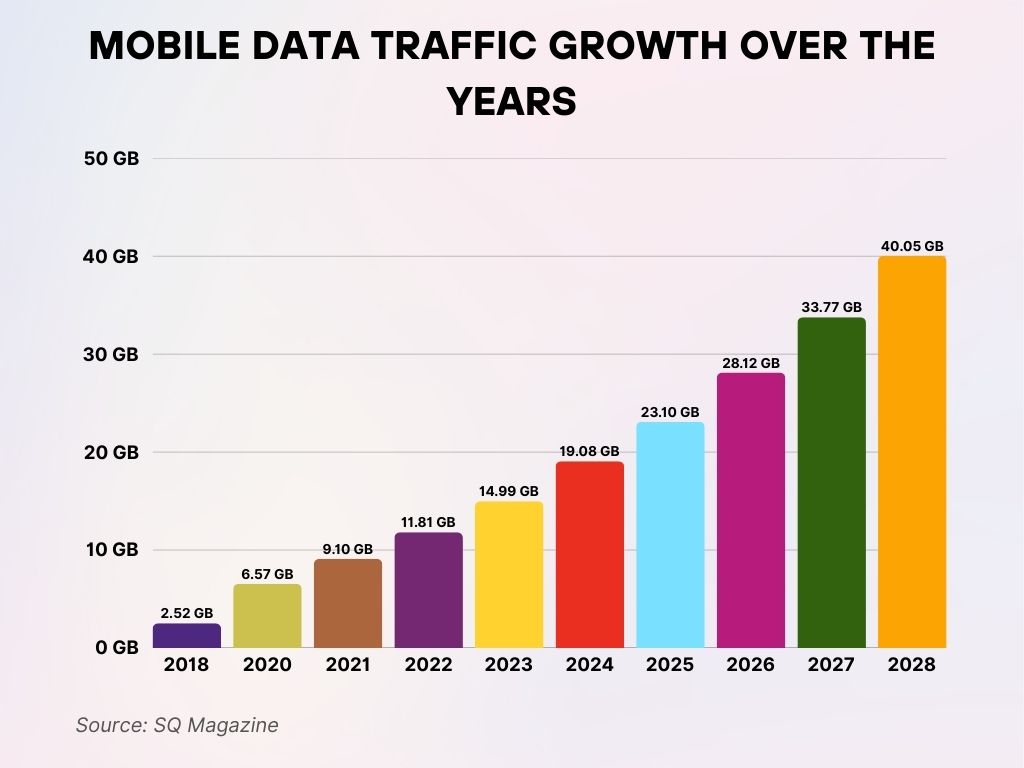
Global Mobile Phone Ownership Rates
- 91% of the global population owns a mobile phone in 2025, compared to 88% in 2024.
- In North America, mobile phone ownership rates peaked at 97% in early 2025.
- Europe follows closely, where 93% of adults own a mobile device.
- In emerging markets like India and Nigeria, mobile phone ownership jumped to 84% and 79%, respectively.
- Urban areas show a 98% mobile ownership penetration, whereas rural areas are slightly lower at 82%.
- Among developed economies, Japan boasts a 99% mobile penetration rate, one of the highest globally.
- Smartphone ownership globally reached 82% in 2025, up from 78% in 2024.
Average Daily Mobile Phone Usage Time
- The global average daily mobile usage climbed to 4.9 hours in 2025.
- US consumers spend an average of 5.2 hours daily on their phones.
- Mobile video consumption accounts for 1.4 hours of total daily phone usage.
- Social media apps occupy about 1.1 hours of daily mobile time.
- Gaming on mobile devices averages 45 minutes daily among users aged 18–34.
- Productivity apps saw a 22% increase in usage time from 2024 to 2025.
- Mobile device multitasking (using two apps simultaneously) now occurs 18% more often than it did in 2024.
Global Mobile Connectivity Statistics
- There are 5.81 billion unique mobile subscribers, representing 70.7% of the world’s population.
- The number of unique mobile subscribers grew by +2.0% year-over-year, an increase of 116 million users.
- Global cellular mobile connections (excluding IoT) reached 8.74 billion, up +1.3% or 114 million connections from the previous year.
- The world has 4.77 billion unique cellular data subscribers, marking a +2.4% increase or 114 million more subscribers.
- The total number of broadband mobile connections stands at 8.28 billion, reflecting strong global mobile internet adoption.
- 94.7% of all mobile connections are now broadband, indicating a shift toward faster mobile internet services.
- The average number of mobile connections per unique subscriber is 1.51, showing that many users maintain multiple connections.
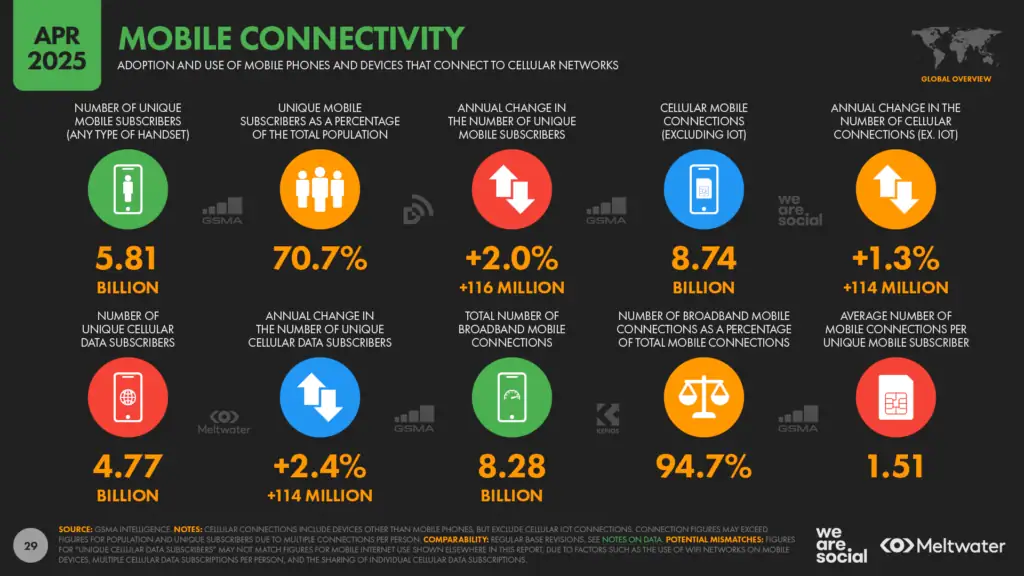
Mobile Phone Usage by Age Group
- 95% of adults aged 18–29 own a smartphone in 2025.
- Teenagers (ages 13–17) spend the most time on mobile phones, averaging 6.1 hours per day.
- Adults aged 30–49 use their mobile phones for 4.8 hours daily on average.
- Senior citizens (65+) have seen a 30% rise in smartphone adoption, reaching 72% ownership.
- Kids aged 8–12 now average 2.7 hours daily on mobile devices.
- The highest app usage among Gen Z (ages 18–24) is social media, accounting for 41% of their phone time.
- Millennials (ages 25–39) show a strong preference for e-commerce apps, with 37% of their shopping done through mobile.
Mobile Phone Usage by Region
- North America leads in mobile phone penetration, with 97% of individuals owning a mobile device as of early 2025.
- In Europe, mobile phone ownership is steady at 93%, with Western Europe accounting for the highest concentration.
- In the Asia-Pacific region, 89% of the population owns a mobile phone, marking a 4% increase from 2024.
- Sub-Saharan Africa witnessed a notable surge, with mobile ownership jumping to 74% in 2025.
- Latin America has reached an ownership rate of 85%, driven by the increased affordability of smartphones.
- Middle Eastern countries, including the UAE and Saudi Arabia, report ownership rates exceeding 95%.
- Rural mobile phone usage globally grew by 9% year-over-year, closing the gap with urban populations.
- Mobile phone dependency is highest in urban China, where 98% of residents own at least one mobile device.
Generations Most Addicted to Their Phones
- 56% of Generation Z report being addicted to their phones, making them the most attached age group to mobile usage.
- 55% of Millennials admit to phone addiction, closely trailing Gen Z in mobile dependency.
- 46% of Generation X identify with phone addiction, showing a moderate level of digital attachment.
- Only 29% of Boomers say they’re addicted to their phones, suggesting lower digital engagement.
- The Silent Generation has the lowest rate, with just 17% feeling addicted to mobile phone use.
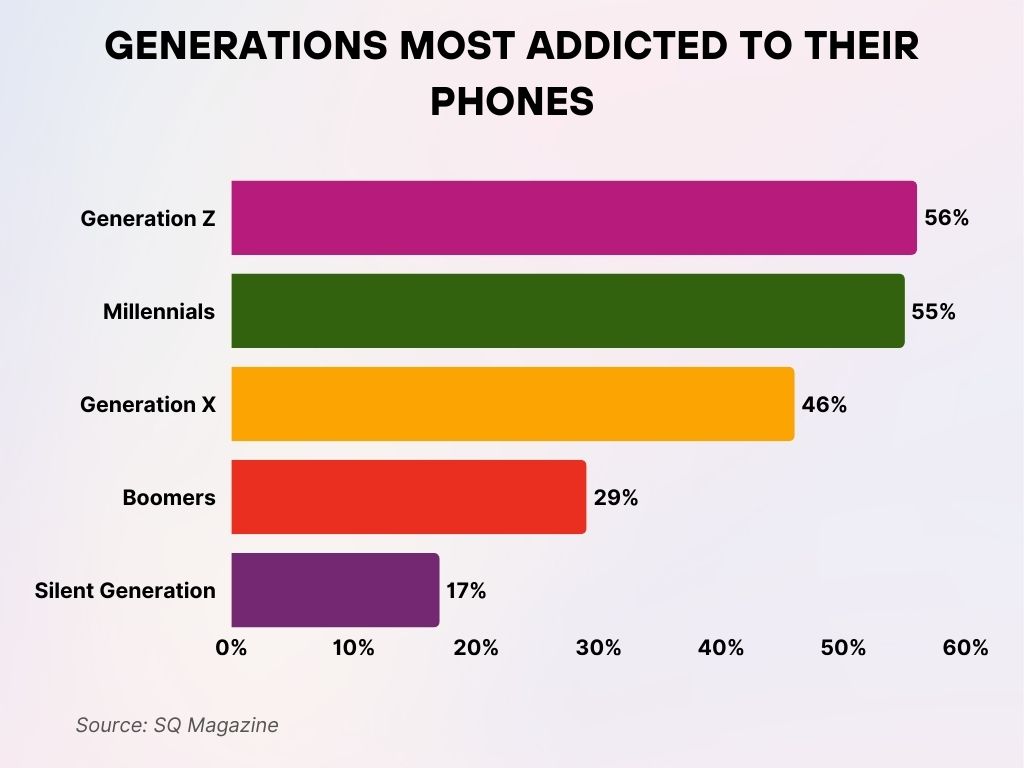
Mobile Internet Usage Trends
- In 2025, 69% of global internet traffic will come from mobile devices.
- In the US, 63% of all web visits are initiated via smartphones.
- Mobile internet usage in India surged by 12% year-over-year, becoming the primary internet access method for 84% of users.
- Video streaming via mobile devices now accounts for 54% of total mobile data usage globally.
- The average mobile internet speed globally has improved to 62 Mbps, up from 55 Mbps in 2024.
- Mobile hotspot usage increased by 18% compared to last year, especially among remote workers.
- Africa’s mobile data consumption per user grew by 21%, indicating accelerated digital adoption.
- Mobile internet usage in Latin America is projected to reach 82% of the total population by the end of 2025.
- 5G networks are now responsible for carrying 35% of global mobile internet traffic.
Popular Activities on Mobile Phones
- Messaging apps remain the most used category, with 92% of mobile users active on apps like WhatsApp, Messenger, and Telegram.
- Mobile video streaming apps like YouTube and Netflix account for 68% of entertainment app usage.
- Mobile gaming holds strong, with 58% of smartphone owners playing games regularly.
- Mobile banking usage grew by 14% in 2025, with 72% of users accessing financial services through apps.
- Social media consumption through mobile now covers 81% of total social media use globally.
- E-book and audiobook apps usage increased by 19% compared to 2024.
- Fitness and wellness apps saw a 27% growth in daily engagement.
- Online learning platforms report that 49% of sessions come from mobile devices.
- Mobile news app usage jumped 22%, particularly during major global events.
How North Americans Use Smartphones While Shopping
- 72% of North American adults use their smartphones for price comparison while shopping in-store.
- 69% rely on their phones for reading customer reviews to make informed purchasing decisions.
- 52% use smartphones to find detailed product descriptions while browsing in physical stores.
- 29% search for brand reputation information during their shopping journey.
- 26% refer to a comparison table of similar products to weigh options before buying.
- Another 26% check product specifications directly from their mobile devices.
- 25% look up product imagery and photography to better visualize their purchases.
- 24% check health and nutritional information for relevant products.
- 21% access the FAQ lists to answer quick product-related queries while shopping.
- 20% watch product videos for a better understanding of how the product works.
- Only 2% cited other reasons for using smartphones while shopping in-store.
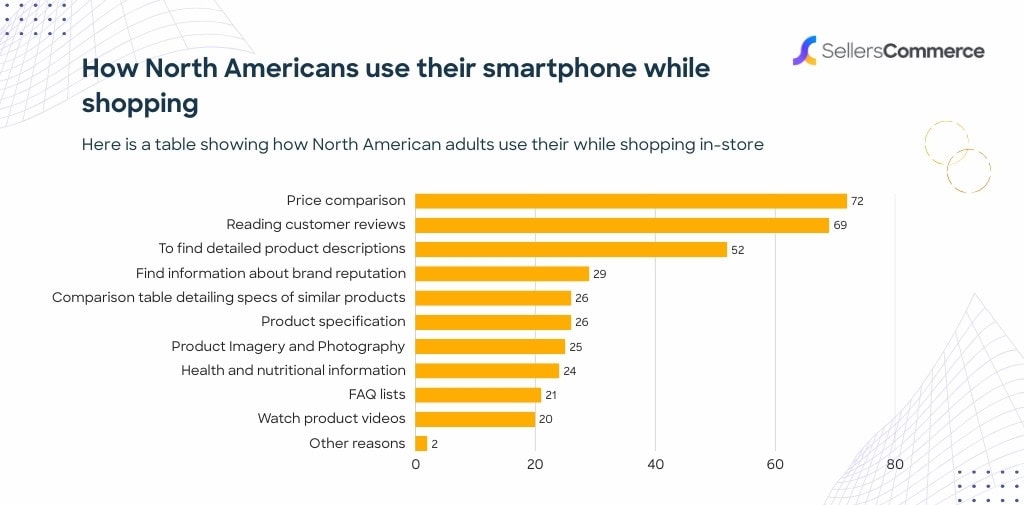
Impact of 5G on Mobile Usage Patterns
- 58% of mobile users globally will be on a 5G network in 2025.
- Mobile download speeds are, on average, 5x faster on 5G compared to 4G.
- Cloud gaming on mobile has risen by 35%, thanks to 5G’s low latency.
- In urban areas, 67% of mobile video content is streamed in 4K quality because of faster 5G speeds.
- Mobile AR (augmented reality) app usage has doubled since the widespread 5G rollout.
- Average mobile data usage per person has increased to 18 GB/month in 2025 from 13 GB/month in 2024.
- Remote work productivity apps used via mobile experienced a 21% boost in session times with better connectivity.
- Mobile live-streaming events, such as concerts and sports, increased audience sizes by 38% in regions with full 5G coverage.
Smartphone Penetration and Growth Forecasts
- Smartphone penetration globally hit 82% in 2025.
- The US smartphone penetration rate reached 91% this year.
- Emerging markets, including Southeast Asia and Africa, saw a 12% growth in smartphone adoption.
- Foldable smartphones are predicted to account for 5.2% of total smartphone shipments by the end of 2025.
- Refurbished smartphone sales are expected to grow by 18% this year.
- Android OS maintains the largest global market share at 71% in 2025.
- iOS devices increased their global market share to 28%, up from 26% in 2024.
- Smartphone shipments worldwide are forecasted to exceed 1.6 billion units by the end of 2025.
- Wearable tech integration with smartphones, like smartwatches, expanded by 22% year-over-year.
Gender Breakdown of iPhone vs Android Users Worldwide
- 60% of Android users are male, while 54% of Android users are female, showing a slight male dominance.
- 28% of male smartphone users prefer iPhones, compared to 31% of female users who favor Apple devices.
- 12% of males and 15% of females fall into the Other category, indicating use of brands outside Android and iPhone.
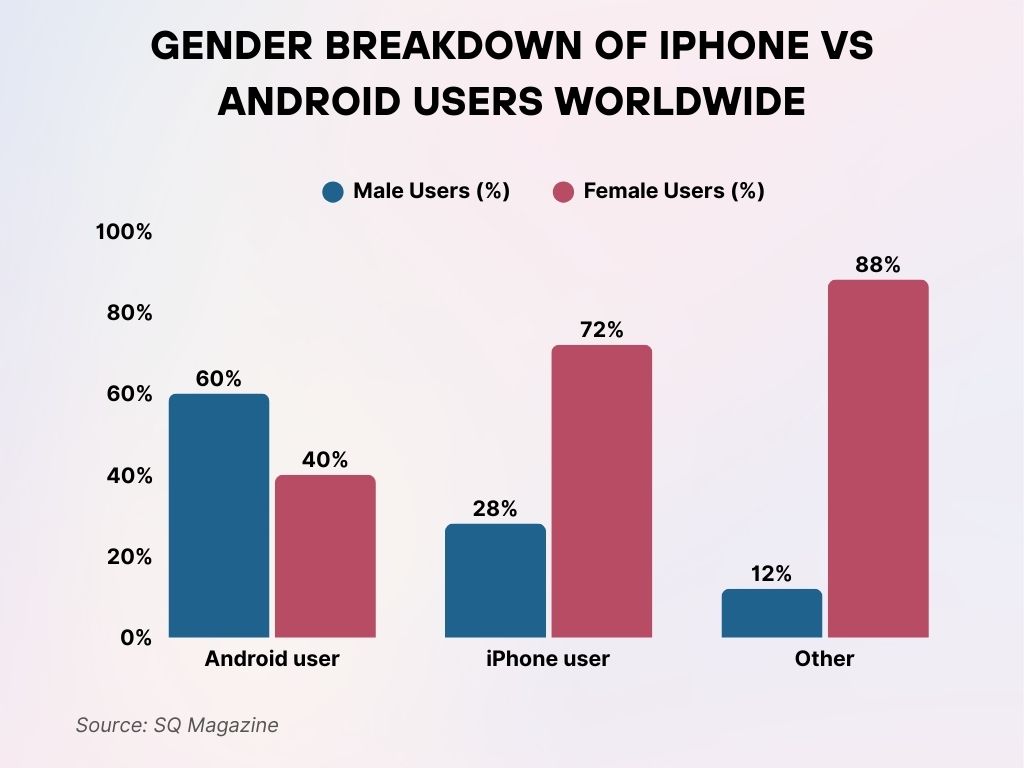
Mobile App Usage Statistics
- The average smartphone user now has 85 apps installed, but actively uses only 30 of them monthly.
- Mobile app downloads reached 260 billion globally in 2025.
- The top-grossing app category remains gaming, contributing to 48% of app revenue.
- Time spent on mobile apps increased by 6%, averaging 4.5 hours per day.
- Subscription-based apps like fitness, meditation, and entertainment saw a 19% boost in user spending.
- Finance apps were the fastest-growing category in terms of downloads, up 23% from 2024.
- Social media apps such as TikTok and Instagram led to user engagement, with an average session time of 33 minutes.
- Productivity apps witnessed a 17% rise in daily active users.
- Mobile food delivery apps like DoorDash and Uber Eats reported a 16% increase in 2025 orders.
- In 2025, users spend an average of 2.5 hours daily on social media via mobile devices.
- Facebook remains the most-used platform globally, with 68% of mobile users accessing it daily.
- TikTok saw the highest growth, with users spending an average of 58 minutes per day.
- Instagram mobile sessions rose by 17%, with users averaging 35 minutes per session.
- Snapchat mobile users increased by 9%, with the app holding strong appeal among Gen Z.
- LinkedIn mobile activity jumped by 14%, driven by the rise in mobile-friendly job searches.
- Twitter (now X) users spend around 22 minutes per day via mobile access.
- Over 90% of YouTube’s global watch time comes from mobile devices.
- Daily active social media users on mobile grew by 8% globally from 2024 to 2025.
Americans’ Cell Phone Usage and Habits
- 89% of Americans check their phones within the first 10 minutes of waking up, highlighting early phone dependency.
- 75% feel uneasy leaving their phone at home, showing how essential smartphones have become.
- 75% also check their phones within 5 minutes of receiving a notification, indicating instant responsiveness.
- 69% use their phones on the toilet, reflecting mobile phone usage even during personal moments.
- 60% sleep with their phone at night, keeping devices close even during rest.
- 57% consider themselves addicted to their phones, showcasing widespread digital addiction concerns.
- 55% have never gone longer than 24 hours without using their phone, underlining constant connectivity.
- 47% experience panic or anxiety when their battery falls below 20%, showing dependence on phone power.
- 27% use or look at their phone during a date, pointing to tech distractions in social settings.
- 27% also use or check their phone while driving, raising safety concerns.
- On average, Americans check their phones 144 times per day, emphasizing habitual smartphone behavior.
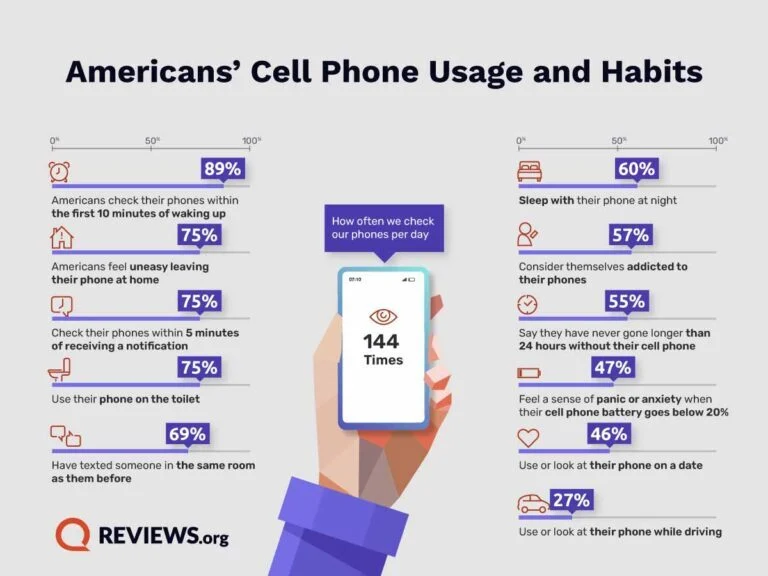
Mobile Device Usage for E-commerce and Payments
- Mobile commerce (m-commerce) is expected to generate $4.3 trillion globally by the end of 2025.
- In the US, 72% of all e-commerce sales now come from mobile devices.
- One-click payments via mobile grew by 23%, making checkout faster and boosting conversions.
- Mobile wallet usage, including apps like Apple Pay and Google Pay, rose by 27% in 2025.
- Buy Now, Pay Later (BNPL) transactions via mobile climbed by 34% compared to last year.
- Mobile shopping cart abandonment rates remain high at 69%, although improved UI designs are lowering this gradually.
- Voice commerce (shopping via voice assistants) increased by 19% on mobile platforms.
- Retail apps saw a 16% increase in monthly active users in 2025.
- Mobile coupon usage surged by 22%, with customers favoring instant digital savings.
Health and Well-being Effects of Mobile Usage
- 42% of US adults report feeling “overwhelmed” by their mobile device usage in 2025.
- Mobile screen time management apps grew by 28% in downloads, indicating rising concern over digital health.
- Teenagers experience a 33% higher risk of sleep disruption linked to excessive mobile use.
- Mobile phone-related eye strain complaints among users rose by 19% compared to 2024.
- Meditation and mental wellness apps grew by 31%, signaling a shift toward healthier device engagement.
- About 24% of adults have implemented “phone-free zones” in their homes.
- Fitness tracking apps usage expanded by 25%, helping users combat the sedentary habits tied to mobile usage.
- Blue light filter usage among mobile users rose by 20% over the past year.
Environmental Impact of Mobile Phone Consumption
- Over 1.5 billion mobile phones are expected to be discarded globally in 2025.
- Only 18% of discarded mobile phones are properly recycled, despite global initiatives.
- The carbon footprint of mobile phone production rose by 7% year-over-year.
- Refurbished phone sales offset approximately 11 million tons of CO2 emissions in 2025.
- Major brands have pledged to use 50% recycled materials in new mobile devices by 2026.
- Mobile device energy efficiency improved by 9%, helping reduce lifetime emissions.
- Smartphone battery recycling program participation rose by 32% globally.
- E-waste awareness campaigns increased in visibility by 21% in North America.
- 5G devices are 18% more energy-efficient than their 4G predecessors over a two-year span.
Recent Developments in Mobile Technology and User Behavior
- AI-powered smartphones accounted for 14% of all new mobile device sales in 2025.
- Satellite connectivity became a standard feature in 7% of flagship smartphones.
- Foldable smartphones saw a 38% increase in shipments year-over-year.
- On-device AI processing (no cloud dependency) grew by 23% in new mobile releases.
- Wearable integration with mobile apps expanded by 22%, creating new lifestyle ecosystems.
- Privacy-focused smartphones became a notable niche, growing 17% in popularity.
- Virtual reality (VR) headsets tethered to mobile phones rose by 31% in sales.
- Gesture control technologies became available on 12% of high-end smartphones.
- Augmented Reality (AR) shopping apps expanded by 29% in user engagement, driven by improved mobile camera technologies.
Conclusion
In 2025, mobile phones will be more than ever the gateway to how we live, work, and interact with the world. With mobile ownership nearing universal levels, daily usage times climbing, and emerging technologies like 5G, AI, and AR revolutionizing how we use our devices, the future of mobile connectivity looks dynamic and transformative. However, these advances also bring new challenges around health, sustainability, and digital balance. As we move forward, the evolution of mobile phone usage will continue to shape industries, lifestyles, and societies across the globe.
Sources
- https://www.statista.com/topics/840/smartphones/
- https://explodingtopics.com/blog/smartphone-usage-stats
- https://electroiq.com/stats/smartphone-usage-statistics/
- https://backlinko.com/smartphone-usage-statistics
- https://www.demandsage.com/smartphone-usage-statistics/
- https://www.slicktext.com/blog/2019/10/smartphone-addiction-statistics/
- https://passport-photo.online/blog/smartphone-usage-statistics/
- https://www.consumeraffairs.com/cell_phones/cell-phone-statistics.html


